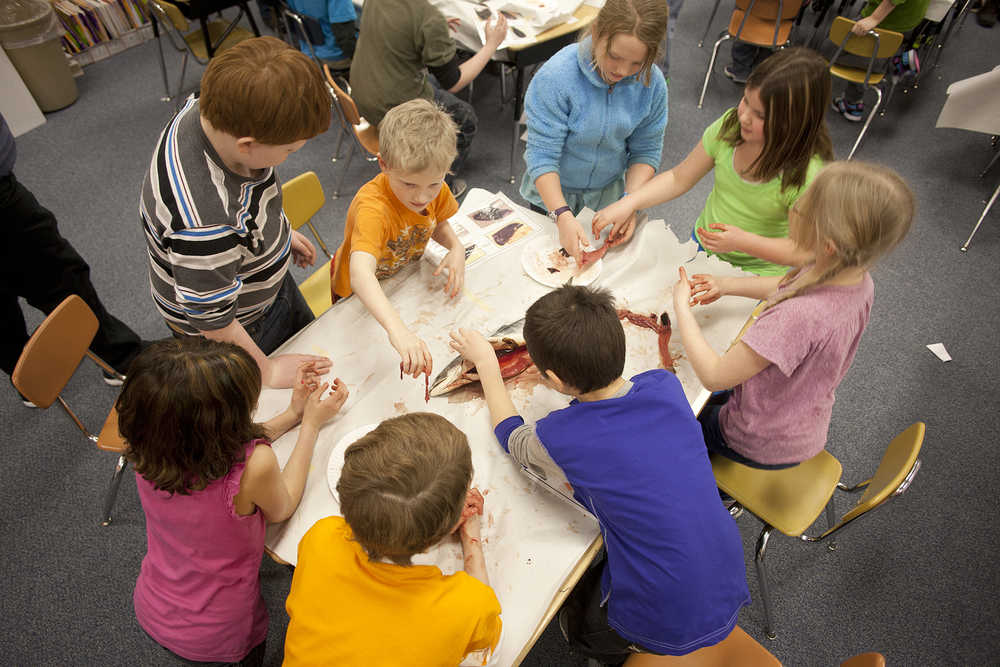Elementary school students’ quarterly report cards will look a little different this year.
The Kenai Peninsula Borough School District has implemented a Standards-Referenced reporting system, which evaluates students’ performances in different skill areas under standards as determined by the Alaska Department of Education and Early Development.
Dr. Chrstine Ermold, KPBSD director of elementary education, said the new system is designed to help students understand where they are in their learning and also to motivate them to go beyond expectations.
“Knowing that this is a move that we’re making because it’s about promoting the success of kids. Where they’re at is so important,” she said.
Under the new system, teachers score students on “strands” in language arts including reading literature, reading informational texts, writing and speaking and listening, among other areas. In math students are graded on “domains,” which include counting and cardinality, operations and algebraic thinking and statistics and probability, along with other skills.
Science, health and social studies only have comment areas where teachers can report what students studied. Music and physical education are graded on a participation basis. Students are graded on classroom community skills as well, which includes demonstrating effort, working cooperatively, following directions, working independently and completing homework, among other skills.
While the scoring key differs slightly among classroom community, music and physical education and language arts and math, in each area students are scored on a 0-4 number system in Marzano’s Modified Scale Score. Ermold said the system was the tool chosen by the Elementary Report Card Committee.
If a student receives a 4 mark in a skill, it means the student exceeded the skills in the standard. A 3 means the student met the standards. If a teacher gives a student a 2 in a skill, it means the student demonstrated some of the skills in the standard. A 1 means that with help, a student demonstrated some skills in the standards. If a student receives a 0, it means even with help the student cannot demonstrate skills in the standard.
“The reason that the committee selected a 0-to-4 scale is because it was really important that when students are able to go above and beyond … that we’re able to reflect that on the report card and not limit our kids by saying, ‘Well, meeting the expectation is the best you can do,’” Ermold said.
If a student is consistently getting 4s in a standard, his or her teacher can record the student’s progress on the grade-level standards, Ermold said. Using this system, Ermold said, will eliminate fears that students who are doing above average work will have to do the same work next year.
“Now we can document their progress on the above-level standards and be able to keep moving them ahead as they’re ready,” she said.
For parents who have students with learning disabilities, they can see what specific skills their children are able to do and to what degree, Ermold said.
Before bringing the system online district-wide in kindergarten through sixth grades, the system was piloted in three area schools, Ermold said. When sixth grade is part of a middle school, she said this model is not used. However, some middle school and high school teachers are interested in a blended grading model that incorporates the Standards-Referenced Reporting. Ermold said she doesn’t think the system will replace the role of traditional grades.
Ermold said many parents ask why can’t the schools use an A through F system.
“Our society really has an idea that we think we know what an A means,” she said. “An A means 100 percent. Well, what goes into that 100 percent?”
She said each teacher has a different idea of what an A means. If a student gets a 70 percent on a test that works on different skills, she said it can be difficult for a child to determine which skill he or she needs to work on.
If student is graded on each skill, he or she will know what to work on, Ermold said.
“So it provides me, as a student, with the tools that I need so that I can do better,” she said.
She said many people also try to compare the two grading systems.
“They want to say, ‘Oh, a 4 must mean an A and a 3 must mean a B,’ and that is not correct,” Ermold said. “You cannot draw that comparison in any way shape or form.”
If a comparison were attempted, a 3 would more accurately represent an A. But a 2 isn’t really a B because a 2 means a student can do some of the standard independently, which would be more closely related to an A, she said.
“A 2 means your kid’s got part of it, that’s great,” Ermold said. “This is what you need to work on next. It should be empowering and informative.”
Ermold said the district will continue to collect parent and teacher feedback to determine how to improve the system.
She said she wouldn’t be surprised if teachers wanted to reconsider the community skills categories assessed and possibly include content standards for physical education and music.
“Right now we just need to get really good at using that 0-to-4 scale for not only reporting on how our students are doing but helping our students use that tool in a way that is motivating and meaningful,” Ermold said.
Kaylee Osowski can be reached at kaylee.osowski@peninsulaclarion.com.

